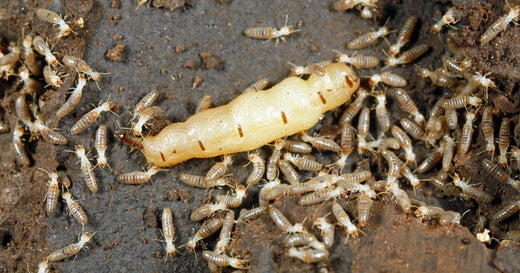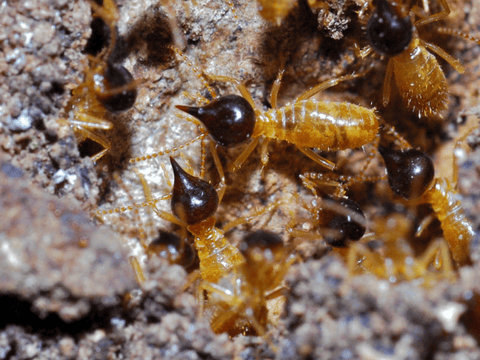What do termites look like? If you don't know yet, you're in for a surprise! In this blog post, we will discuss the different types of termites Australia has and what they look like. There are more than 2,000 species of termites in the world, so it can be difficult to know which one you are dealing with. Each type of termite has its own unique characteristics, so it is important to learn what to look for. In Australia, there are several types of termites that are common. Keep reading to learn more!
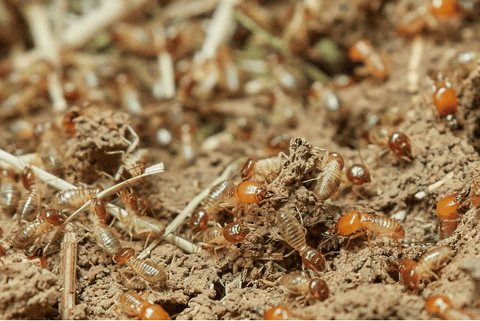
Image by Roy Buri
What are termites
Termites are small insects that live in colonies in wood. They are a major problem for homeowners because they can cause extensive damage to houses and other buildings. Termites are wood-destroying insects that are found in warm climates around the world.
Although they are often considered to be pests, termites play an important role in the ecosystem by breaking down dead wood and other organic matter.
What termites look like
Termites are small, winged insects that are closely related to cockroaches. These little insects are about ¼ to ½ inch long, with a wide thorax and straight antennae. They come in a variety of colors, including brown and black. What about white ants? What do white ants look like? Termites can also look the same as them. While most termites stay on the ground, swarmers have two sets of wings that allow them to fly.
Different species of termites
There are three main types of termites: subterranean, drywood, and dampwood. Subterranean termites live in the soil and build tunnels to reach their food source, which is typically wood that is in contact with the ground. Drywood termites live in dry wood and do not require contact with the soil. Dampwood termites live in damp or rotting wood and also require contact with the ground. Termites cause billions of dollars in damage each year by eating the wood structural support beams in homes and other buildings.
Where do termites live
Termites are small, winged insects that live in colonies underground. These colonies can number in the millions and can span hundreds of acres. Termites build their nests by excavating soil and using it to construct earthen tubes. These tubes allow them to travel between their nest and food sources without being exposed to the elements. Termites are attracted to wood, which they use for both food and shelter. They typically enter structures through cracks in the foundation or gaps around doors and windows. Once inside, they can cause extensive damage to wooden beams and support structures. Termites can also damage drywall, insulation, and electrical wiring. If left unchecked, a termite infestation can quickly destroy a home or building.
Different species of termites in Australia
There are more than 300 different species of termites in Australia, each with its own unique set of behaviors and preferences. Some of the most common species of termites in Australia include:
- Cryptotermes
- Heterotermes ferox
- Coptotermes
- Microcerotermes
- Mastotermes
- Porotermes
- Schedorhinotermes
- Nasutitermes
Homeowners in Australia have a lot to worry about when it comes to termites. Of all the termite species found in Australia, the subterranean coptotermes species is the most destructive. These native Australian species are responsible for causing millions of dollars in damage to homes each year.
Cryptotermes
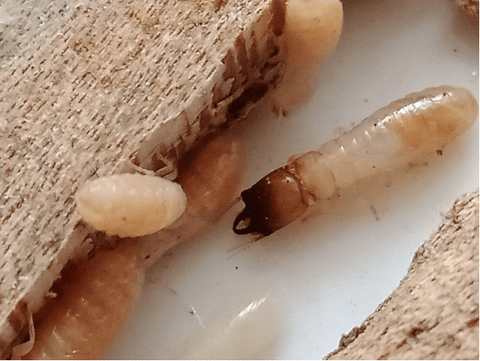
Cryptotermes, or West Indian Dry-Wood Termites, are one of the most common Australian termite species. Cryptotermes is a small, Australian termite species that cause extensive damage to timber structures. They are difficult to detect as they leave no outward signs of damage until the structure collapses. These termites have low water requirements and survive off small pieces of timber. The average soldier is 4.2-6mm long and has a wrinkled head. There are many different species of termites in Australia, but cryptotermes are the most common and widespread. If you suspect that your home or business is infested with these pests, it is important to contact a pest control professional immediately.
Heterotermes ferox

Heterotermes ferox is one of the many species of termites found in Australia. As its name suggests, heterotermes ferox is a rather aggressive species that is known for damaging weathered wood, such as poles, fences, posts, and flooring. While it is not considered to be a major economic pest, Heterotermes ferox can still cause significant damage to sound timber. Colonies of heterotermes ferox are subterranean and relatively small, but multiple colonies can often be found close together. The Heterotermes ferox species of soldiers and workers are not very aggressive when disturbed, and they move slowly. The average soldier is 3.5-7.5 mm in length, with a rectangular head and long mandibles to match. All in all, Heterotermes ferox is yet another Australian termite species that can cause problems for homeowners and businesses alike.
Coptotermes

There are over 300 species of termites in Australia, and Coptotermes is one of the most destructive. This termite is found all across the country and has been known to cause extensive damage to buildings and other structures. Coptotermes build their nests in tree stumps, walls, and patios, and their colonies can number in the millions. These termites are also able to travel great distances in search of food, using a network of underground tunnels. The coptotermes builds underground tunnels that can stretch up to 50m in length. These tunnels are used to access new sources of food, as the coptotermes feeds on wood. The head of the soldier caste is rectangular and pear-shaped, with dark mandibles. The body of this termite is up to 7mm in length. If you suspect that you have a coptotermes infestation, it is important to contact a qualified pest control professional as soon as possible.
Microcerotermes

Microcerotermes is a genus of australian termites that comprises three species: Microcerotermes turneri, Microcerotermes serratus and Microcerotermes distinctus. These termites are found across most of mainland Australia, from tropical north Queensland to Sydney in New South Wales. They have a mixture of nesting habits, with some building small on-ground mounds, some nesting underground, and others building the iconic arboreal mounds with stalactites dripping from underneath. These arboreal mounds can be found halfway up a tree trunk or on the top of fence posts.
Mastotermes

The mastotermes darwiniensis, more commonly known as the giant termite, is the most destructive type of termite found in Australia. These pests are capable of causing extensive damage to buildings and agricultural products and can do so at an alarming rate. An adult giant termite is approximately 11-13 mm long, with a rounded yellow-to-reddish brown head and short black mandibles. Alates, or winged reproductive adults, can reach up to 35 mm in length, with a wingspan of 50 mm. Giant termites are most active during the wet season when they swarm in large numbers to form new colonies. If you have this type of termite in your home, it is important to call a professional pest control company to get rid of them. Otherwise, they will continue to damage your home and property.
Porotermes
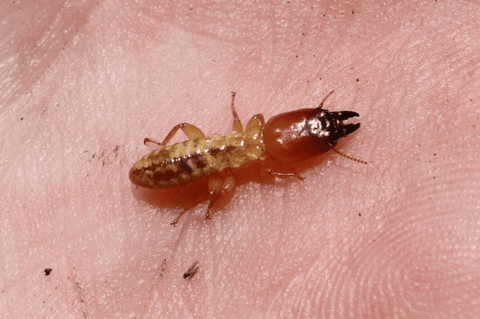
Porotermes termites are a species of termite that is native to Australia. They are often called "dampwood termites" because they require damp and decaying wood to initiate an attack. Porotermes termites typically live in colonies that consist of three different castes: soldiers, workers, and reproductives. The soldiers are responsible for defending the colony, while the workers gather food and build the nest. The reproductives are the only members of the colony that can mate and produce new offspring. Porotermes termites are a major pest in Australia, and they are known for attacking wooden structures that are in contact with soil. This includes fence posts, weatherboards, and telephone poles. Older homes that are damaged by poor plumbing are especially at risk of an attack by Porotermes termites. The termites have orange heads and their bodies are rectangular in shape with black-toothed jaws. They can grow up to 2 cm long and they usually live in small independent groups rather than large colonies. These termites are majorly found in the southwestern and eastern mainland of Australia. If you think you may have a problem with these pests, it is important to contact a professional exterminator as soon as possible.
Schedorhinotermes
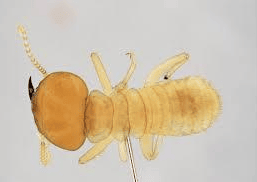
The Schedorhinotermes is a species of termite that is commonly found in eastern and southeastern Queensland and along the coastline. These termites are mostly active during the summer months when they build their nests in tree stumps or the root crowns of living or dead trees. This species of termite is also known to build its nests under buildings or within enclosed patio areas. The workers in this species grow up to 3-5 mm in length and are pale brown in color. These termites have two types of soldiers, called major and minor. The minor soldier is 3.0-5.0 mm long with a narrow head, while the major soldier is 5.0-7.5 mm long with a bulbous head. The Schedorhinotermes is considered to be a serious pest species due to the damage it can cause to wooden structures, such as houses and buildings. If you suspect that you have a Schedorhinotermes infestation, it is important to contact a pest control professional for assistance.
Nasutitermes are small, pale-orange insects that live in colonies in damp, weathered wood. Their bodies are up to 4mm long and they have a pointed snout, or nasute. The soldiers among them are smaller than the workers, and their primary job is to protect the colony from predators. These insects are not harmful to humans, but they can cause damage to property by eating away at decking boards and other wooden structures. In most cases, Nasutitermes will only attack wood that is already in a state of decay, but they can occasionally cause problems for homeowners by damaging sound timber. If you suspect that you have Nasutitermes on your property, it is best to contact a pest control professional for assistance.
The Many Phases of a Termite's Life
Believe it or not, termites go through quite a few changes during their lifetime. In fact, they have four distinct phases: egg, nymph, soldier, and adult. Let's take a closer look at what each of these phases entails.
Eggs
All termites start out as eggs. Once they hatch, they enter the nymph phase.
Nymphs
Nymphs are immature termites that undergo a series of molts before becoming adults. During this phase, they perform many of the same tasks as adults, such as feeding on wood and other cellulose-based materials. However, they are not yet sexually mature and are not able to reproduce.
Soldiers
The soldier caste's primary purpose is to defend the colony from attacks by predators such as ants. They have large mandibles that they use to bite intruders.
Adults
Once termites reach adulthood, they are sexually mature and can mate with other members of the colony. There are two types of adult termites: workers and reproductives. Workers make up the majority of the colony and are responsible for gathering food and caring for the young. Reproductives are responsible for mating and producing new offspring.
As you can see, there is a lot more to a termite's life than meets the eye! These fascinating creatures undergo a number of changes during their lifetime, ultimately emerging as adults that play an important role in their colony.
What bugs can be mistaken for termites?
Have you ever seen a bug in your home and thought to yourself, "is that a termite?" It's a common mistake, especially if you're not familiar with all the different types of insects that can find their way into your home. In this blog post, we'll take a close look at five different types of pests that are often mistaken for termites.
Carpenter Ants
One of the most common household pests, carpenter ants get their name from their habit of tunneling through the wood to build their nests. These ants are usually black or red and range in size from ⅛ to ½ an inch long. While they don't eat wood like termites, carpenter ants can cause damage to your home if left unchecked.
Flying Ants
Another type of ant that is often mistaken for termites is flying ants. These insects are actually winged male and female carpenter ants who leave their nests in search of mates. After they've found a mate, they shed their wings and start a new colony. If you see what you think are flying termites, take a closer look - if they have wings, they're not termites!
Acrobat Ants
Acrobat ants get their name from their habit of raising their abdomens over their heads when disturbed - kind of like a human performing an acrobatic stunt! These small ants range in color from light brown to black and are only about 1/8th of an inch long. Acrobat ants generally nest outdoors but can sometimes find their way into homes through cracks and holes in the foundation or walls.
Carpenter Bees
While they may look like bees, carpenter bees are actually more closely related to wasps. These bees get their name from their habit of boring holes into wood so that they can lay their eggs inside - much like carpenter ants! Carpenter bees range in size from ½ to 1 inch long and are usually black with yellow markings on their abdomens. Unlike honeybees, carpenter bees are not social insects and live alone or in small groups. While they don't eat wood like termites, carpenter bees can cause serious damage to your property if left unchecked.
Powderpost Beetles
Powderpost beetles get their name from the fine powdery substance they leave behind as they bore into wood. These small beetles range in size from ⅛ to ¼ of an inch long and vary in color depending on the type of beetle. Powderpost beetles generally attack hardwoods like oak, maple, and mahogany but can also infest softwoods like pine and cedar if given enough time.
Summary
Although it is not always possible to identify the species of termite, some key features can help you determine whether or not you are dealing with a termite infestation. If you have any concerns about an infestation in your home or business, don’t hesitate to contact a professional for assistance. Termites can cause serious damage to homes and businesses if left untreated, so it is important to take action as soon as possible if you think you might have a problem. Now that you know how to identify different species of termites and their life cycle, it's important to take steps to protect your home from these pests. Have you found any evidence of termites in your home?

